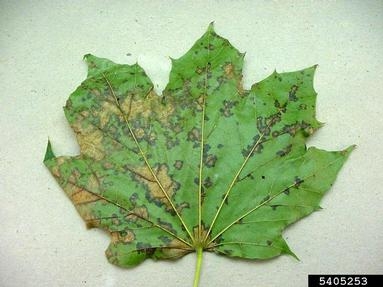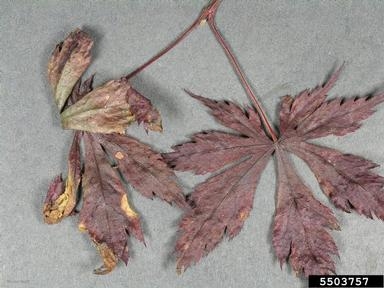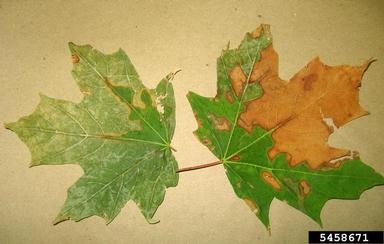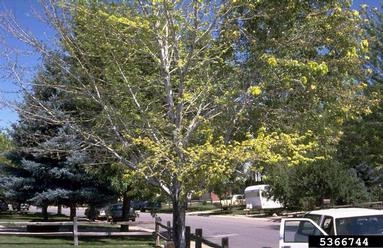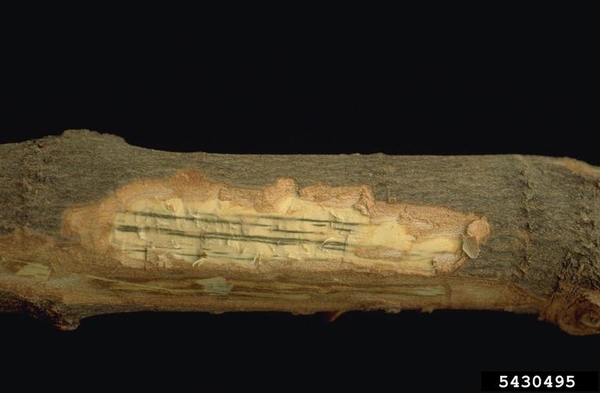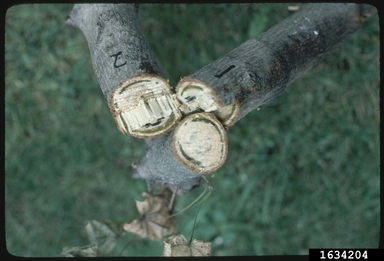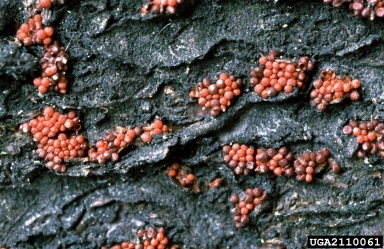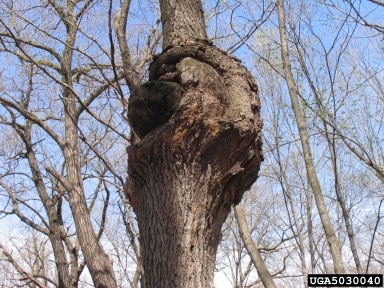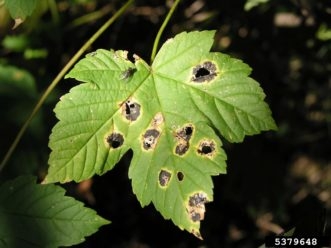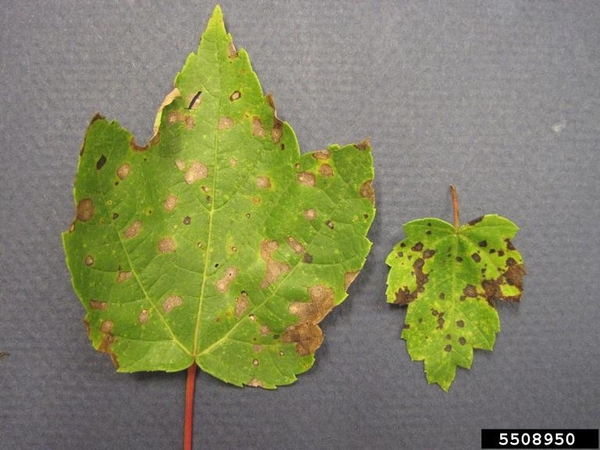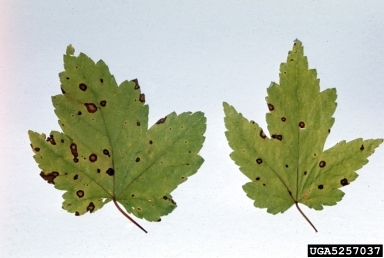Anthracnose
Anthracnose (caused by Aureobasidium apocryuptum, Discula campestris, Colletotrichum gleosporoides, and other fungal pathogens) is a broad term used for a variety of fungal diseases that infect hardwoods such as maple, sycamore, oak, ash, and dogwood. Anthracnose causes distinctive lesions on leaves, twigs, and fruit. Lesions often have distinct margins and are located along leaf veins, where water may linger and promote fungal growth. They appear in the spring and expand as the leaf grows into the summer. The symptoms of anthracnose can vary with the species of fungus and host. Anthracnose is primarily an aesthtic concern and does not impact established trees. However, in rare cases, large infections and disease presence may kill young shoots and cause dieback. The most important management strategy is sanitation: removing infected fallen leaves can help prevent the spread of spores onto next year’s foliage. More information about maple anthracnose symptoms and management can be found from Michigan State University Extension.
Bacterial Leaf Scorch
Bacterial leaf scorch (caused by Xylella fastidiosa) is a disease that affects a variety of shade trees, including maple, oak, elm, sycamore, and sweetgum. The bacterium resides in the xylem tissue of the host plant, and is vectored by leafhoppers, sharpshooters, and other insects that feed on xylem. There are a variety of leaf scorches caused by many agents, including fungi and abiotic factors. However, bacterial leaf scorch has a characteristic dull red to brown appearance with a ‘halo’ between scorched and healthy tissue. The leaves may completely brown and drop prematurely as the disease progresses. Years of successive symptoms may cause branch dieback and the eventual death of the tree. Management includes cultural control and extensive sanitation of infected branches. More information about symptoms and treatment of scorch diseases can be found from NC State Extension.
Verticillium Wilt
Verticillium wilt (caused by Verticillium spp.) is a serious fungal disease that affects over 300 species of trees and shrubs across the United States. Maple and ash are the trees most frequently and seriously affected by the pathogen. The Verticillium fungus lives in the soil and infect plants through their roots. It can lay dormant for many years before afflicting the tree. The first symptom of Verticillium wilt is sudden wilting of leaves and branch dieback. In the sapwood directly underneath the bark, there may be green to brown streaking. Unfortunately, verticillium wilt is incurable and often fatal. Sanitation is essential in stopping the spread of this disease from branch-to-branch or tree-to-tree. Additionally, planting immune or resistant trees will prevent further fatality in soils with the Verticillium fungus. More information about verticillium wilt is available from University of Wisconsin Extension.
Nectria Canker
Nectria canker (caused by Neonectria galligena and Neonectria cinnabarina) is a disease of several trees and shrubs. Among maples, it is especially common in red and sugar maples (Acer rubrum and Acer saccharum, respectively). Nectria canker is a concern for newly established and stressed trees and shrubs, as the cankers grow when the host is stressed. The main symptom of this disease is the production of dark and wet areas on branches and twigs. These may occur due to injury afflicted to the tree, caused by improper pruning, insects, mammals, and storm damage. The tree may respond by forming callus tissue over time, forming cankers. The pathogen can cause serious damage and can be fatal if the infection is widespread; however, otherwise healthy trees can live for many years with the disease. Nectria canker is incurable, but removing branches with cankers can help to slow the spread. Additionally, keeping trees healthy with proper cultural care can prevent the disease from establishing and spreading. More information about Nectria canker is available from University of Wisconsin Extension.
Tar Spot
Tar spot (caused by Rhytisma spp.) is a fungal disease that causes raised black spots on leaf surfaces. The name “tar spot” refers to the spots being tar-like in appearnace. The first signs of infection occur in early-mid summer as yellow spots. In late summer, raised, shiny black spots will grow within the yellow spots. Though these spots are among the most showy foliar diseases, the disease is rarely damaging to trees. Large infestations year-after-year may cause leaf drop. Like some other fungal pathogens, Rhytisma survives the winter on infected leaves, so fall/winter raking and sanitation is essential in controlling this disease. More information about tar spot is available from the Cornell University Plant Disease Diagnostic Clinic.
Phyllosticta / Purple Bordered Leaf Spot
Phyllosticta/purple bordered leaf spot (caused by Phyllosticta minima) is a foliar disease that most frequently affects Japanese, red, silver, and sugar maple. The pathogen overwinters on the forest floor in leaf litter. Rain and wind transfer spores to young leaves in early spring, which may spread throughout the tree canopy. The main sign of this disease is characteristic spots with yellow to brown centers and purple borders dotting the leaf. Black fruiting bodies, called pycnidia, sometimes form in the center of the spots. These may fall out as the disease progresses, leaving holes in the leaf. Though this disease is unsightly, it does not typically cause serious damage. However, consecutive years of unnoticed damage can cause defoliation. The main management strategy of this disease is regular disposal of leaf litter under the tree. More information about Phyllosticta/Purple bordered leaf spot is available from University of Wisconsin Extension.
Powdery Mildew
Powdery mildew (caused by various fungi) is a common fungal disease of many species of trees and shrubs in North Carolina. The disease is characterized by white to gray spots, patches, or powder on leaves. Black or orange fruiting bodies may also be present on the undersides of leaves and new shoots. The fungi thrive and spread most readily in humid conditions. Severe infestations may cause premature leaf drop, but powdery mildew does not usually cause severe damage to trees. Managing powdery mildew usually consists of maintaining health and properly spaced trees and shrubs. More information about powdery mildew on trees is available from University of Minnesota Extension.
References
Brazee, N. J. (2015, April). Maple Anthracnose. UMass Extension Landscape, Nursery, and Urban Forestry Program.
Byrne, J. (2009, June 5). Maple Anthracnose. MSU Extension.
Engelbrecht, C. (n.d.). Verticillium Wilt - A Serious Disease of Trees and Shrubs. Iowa State University Extension and Outreach.
Eshleman, R., & Oten, K. (2022, April 5). Common Disease Pests of Oak in North Carolina. NC State Extension.
Gauthier, N. (2021, November). Bacterial Leaf Scorch of Shade Trees. University of Kentucky Extension.
Gould, A.B. and Lashomb, J.H. 2005. Bacterial Leaf Scorch of Shade Trees. APSnet Features. doi: 10.1094/APSnetFeature/2005-110
Gruber, B., Jahn, C. E., Stanosz, G., & Hudelson, B. (2012, August 13). Purple Bordered Leaf Spot. Wisconsin Horticulture Division of Extension.
Hudelson, B. (2013, May 5). Verticillium Wilt of Trees and Shrubs. Wisconsin Horticulture Division of Extension.
Jensen, S. (n.d.). Tar Spot of Maple. Cornell University Plant Disease Diagnostic Clinic.
Jones, R., Baker, J., & McGraw, J. (2019, October 28). Scorch Diseases on Shade Trees. NC State Extension.
Joy, A., & Hudelson, B. (2012, August 13). Nectria Canker. Wisconsin Horticulture Division of Extension.
Kleupfel, M., Scott, J. M., Blake, J. H., Gorsuch, C. S., & Williamson, J. (2021, February 17). Maple Diseases & Insect Pests. Clemson Cooperative Extension Home & Garden Information Center.
Koetter, R., & Grabowski, M. (2018). Powdery mildew on trees and shrubs. University of Minnesota Extension.
Pijut, P. M. (n.d.). Diseases in Hardwood Tree Plantings. Purdue University Extension.
Publication date: May 13, 2022
N.C. Cooperative Extension prohibits discrimination and harassment regardless of age, color, disability, family and marital status, gender identity, national origin, political beliefs, race, religion, sex (including pregnancy), sexual orientation and veteran status.


